Entrepreneurship and Small Business Management Report - UK College
VerifiedAdded on 2021/02/20
|16
|4436
|20
Report
AI Summary
This report provides a comprehensive overview of entrepreneurship and small business management. It begins by defining entrepreneurship and exploring various entrepreneurial ventures, including public, private, and social ventures, and their typologies such as lifestyle, serial, and scalable. The report then analyzes the similarities and differences between these ventures, considering aspects like annual growth rate, management style, and exit strategies. Furthermore, it examines the significant contribution of small and micro businesses to the growth of the UK economy, highlighting their role in employment and revenue generation, and their importance in developing the social economy. The report also assesses the traits and skills of successful entrepreneurs and explores how their background and experiences foster entrepreneurship. It uses statistical data and examples to support its claims, providing a detailed understanding of the subject.

ENTREPRENEURSHIP AND SMALL
BUSINESS MANAGEMENT
BUSINESS MANAGEMENT
Paraphrase This Document
Need a fresh take? Get an instant paraphrase of this document with our AI Paraphraser
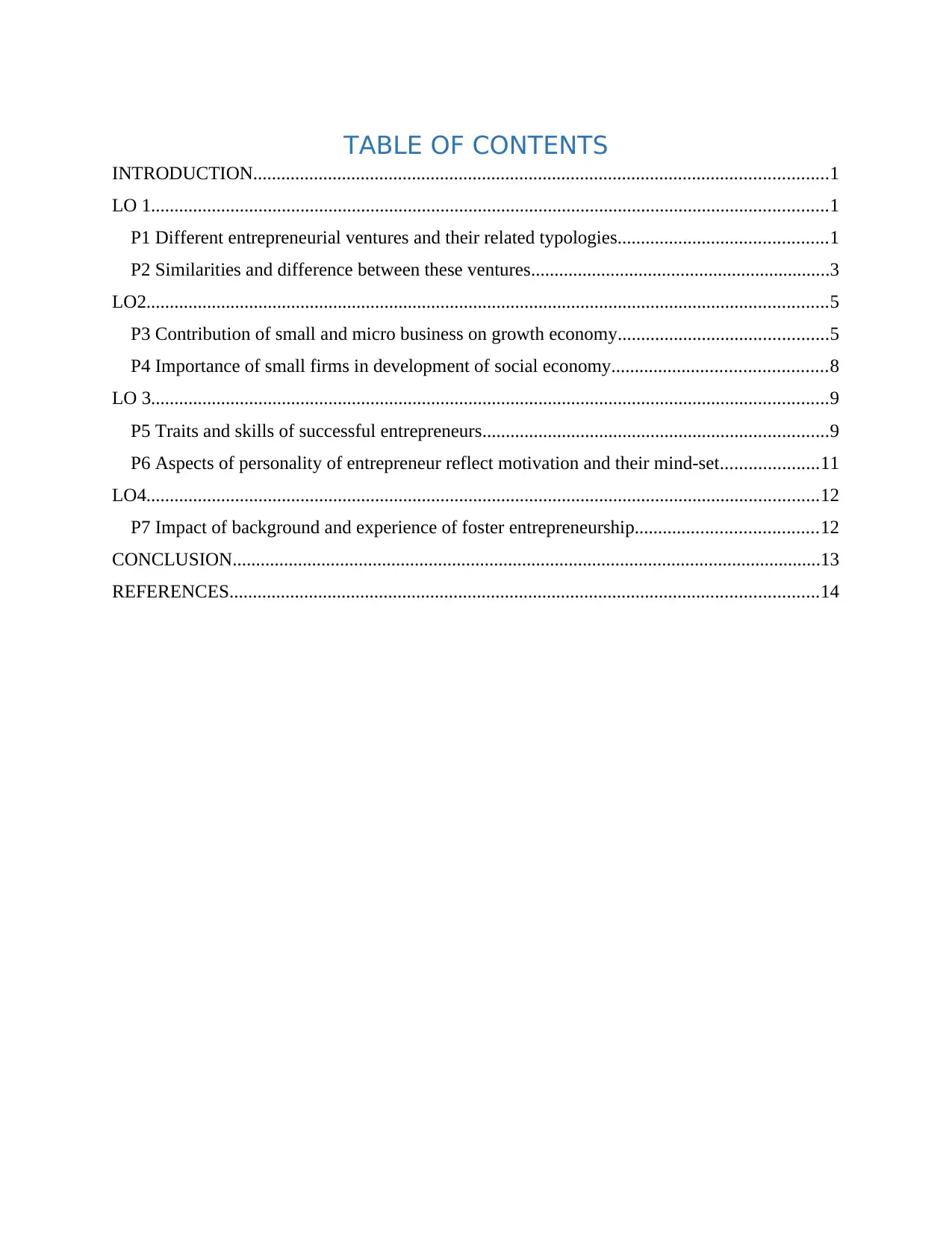
TABLE OF CONTENTS
INTRODUCTION...........................................................................................................................1
LO 1.................................................................................................................................................1
P1 Different entrepreneurial ventures and their related typologies.............................................1
P2 Similarities and difference between these ventures................................................................3
LO2..................................................................................................................................................5
P3 Contribution of small and micro business on growth economy.............................................5
P4 Importance of small firms in development of social economy..............................................8
LO 3.................................................................................................................................................9
P5 Traits and skills of successful entrepreneurs..........................................................................9
P6 Aspects of personality of entrepreneur reflect motivation and their mind-set.....................11
LO4................................................................................................................................................12
P7 Impact of background and experience of foster entrepreneurship.......................................12
CONCLUSION..............................................................................................................................13
REFERENCES..............................................................................................................................14
INTRODUCTION...........................................................................................................................1
LO 1.................................................................................................................................................1
P1 Different entrepreneurial ventures and their related typologies.............................................1
P2 Similarities and difference between these ventures................................................................3
LO2..................................................................................................................................................5
P3 Contribution of small and micro business on growth economy.............................................5
P4 Importance of small firms in development of social economy..............................................8
LO 3.................................................................................................................................................9
P5 Traits and skills of successful entrepreneurs..........................................................................9
P6 Aspects of personality of entrepreneur reflect motivation and their mind-set.....................11
LO4................................................................................................................................................12
P7 Impact of background and experience of foster entrepreneurship.......................................12
CONCLUSION..............................................................................................................................13
REFERENCES..............................................................................................................................14
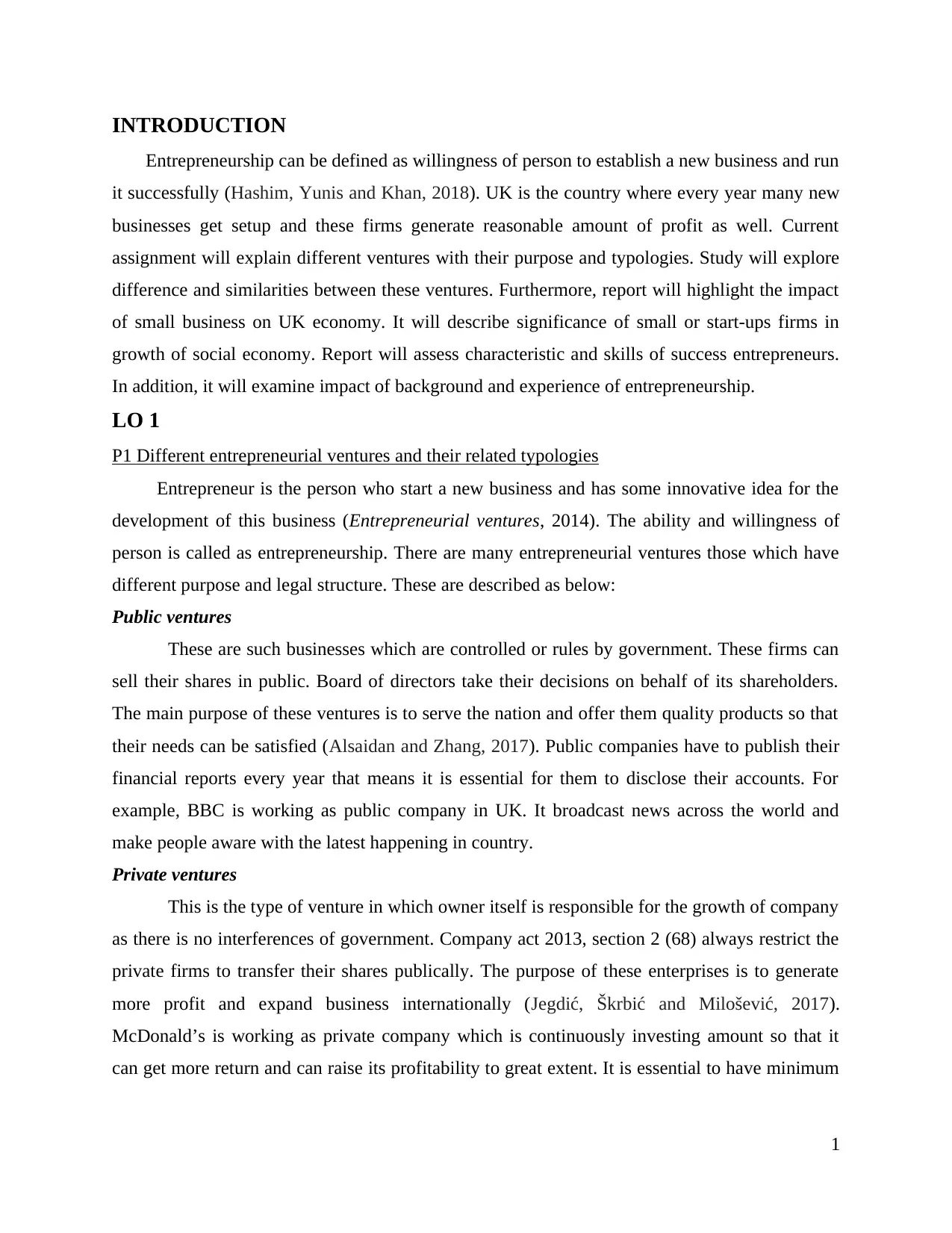
INTRODUCTION
Entrepreneurship can be defined as willingness of person to establish a new business and run
it successfully (Hashim, Yunis and Khan, 2018). UK is the country where every year many new
businesses get setup and these firms generate reasonable amount of profit as well. Current
assignment will explain different ventures with their purpose and typologies. Study will explore
difference and similarities between these ventures. Furthermore, report will highlight the impact
of small business on UK economy. It will describe significance of small or start-ups firms in
growth of social economy. Report will assess characteristic and skills of success entrepreneurs.
In addition, it will examine impact of background and experience of entrepreneurship.
LO 1
P1 Different entrepreneurial ventures and their related typologies
Entrepreneur is the person who start a new business and has some innovative idea for the
development of this business (Entrepreneurial ventures, 2014). The ability and willingness of
person is called as entrepreneurship. There are many entrepreneurial ventures those which have
different purpose and legal structure. These are described as below:
Public ventures
These are such businesses which are controlled or rules by government. These firms can
sell their shares in public. Board of directors take their decisions on behalf of its shareholders.
The main purpose of these ventures is to serve the nation and offer them quality products so that
their needs can be satisfied (Alsaidan and Zhang, 2017). Public companies have to publish their
financial reports every year that means it is essential for them to disclose their accounts. For
example, BBC is working as public company in UK. It broadcast news across the world and
make people aware with the latest happening in country.
Private ventures
This is the type of venture in which owner itself is responsible for the growth of company
as there is no interferences of government. Company act 2013, section 2 (68) always restrict the
private firms to transfer their shares publically. The purpose of these enterprises is to generate
more profit and expand business internationally (Jegdić, Škrbić and Milošević, 2017).
McDonald’s is working as private company which is continuously investing amount so that it
can get more return and can raise its profitability to great extent. It is essential to have minimum
1
Entrepreneurship can be defined as willingness of person to establish a new business and run
it successfully (Hashim, Yunis and Khan, 2018). UK is the country where every year many new
businesses get setup and these firms generate reasonable amount of profit as well. Current
assignment will explain different ventures with their purpose and typologies. Study will explore
difference and similarities between these ventures. Furthermore, report will highlight the impact
of small business on UK economy. It will describe significance of small or start-ups firms in
growth of social economy. Report will assess characteristic and skills of success entrepreneurs.
In addition, it will examine impact of background and experience of entrepreneurship.
LO 1
P1 Different entrepreneurial ventures and their related typologies
Entrepreneur is the person who start a new business and has some innovative idea for the
development of this business (Entrepreneurial ventures, 2014). The ability and willingness of
person is called as entrepreneurship. There are many entrepreneurial ventures those which have
different purpose and legal structure. These are described as below:
Public ventures
These are such businesses which are controlled or rules by government. These firms can
sell their shares in public. Board of directors take their decisions on behalf of its shareholders.
The main purpose of these ventures is to serve the nation and offer them quality products so that
their needs can be satisfied (Alsaidan and Zhang, 2017). Public companies have to publish their
financial reports every year that means it is essential for them to disclose their accounts. For
example, BBC is working as public company in UK. It broadcast news across the world and
make people aware with the latest happening in country.
Private ventures
This is the type of venture in which owner itself is responsible for the growth of company
as there is no interferences of government. Company act 2013, section 2 (68) always restrict the
private firms to transfer their shares publically. The purpose of these enterprises is to generate
more profit and expand business internationally (Jegdić, Škrbić and Milošević, 2017).
McDonald’s is working as private company which is continuously investing amount so that it
can get more return and can raise its profitability to great extent. It is essential to have minimum
1
⊘ This is a preview!⊘
Do you want full access?
Subscribe today to unlock all pages.

Trusted by 1+ million students worldwide
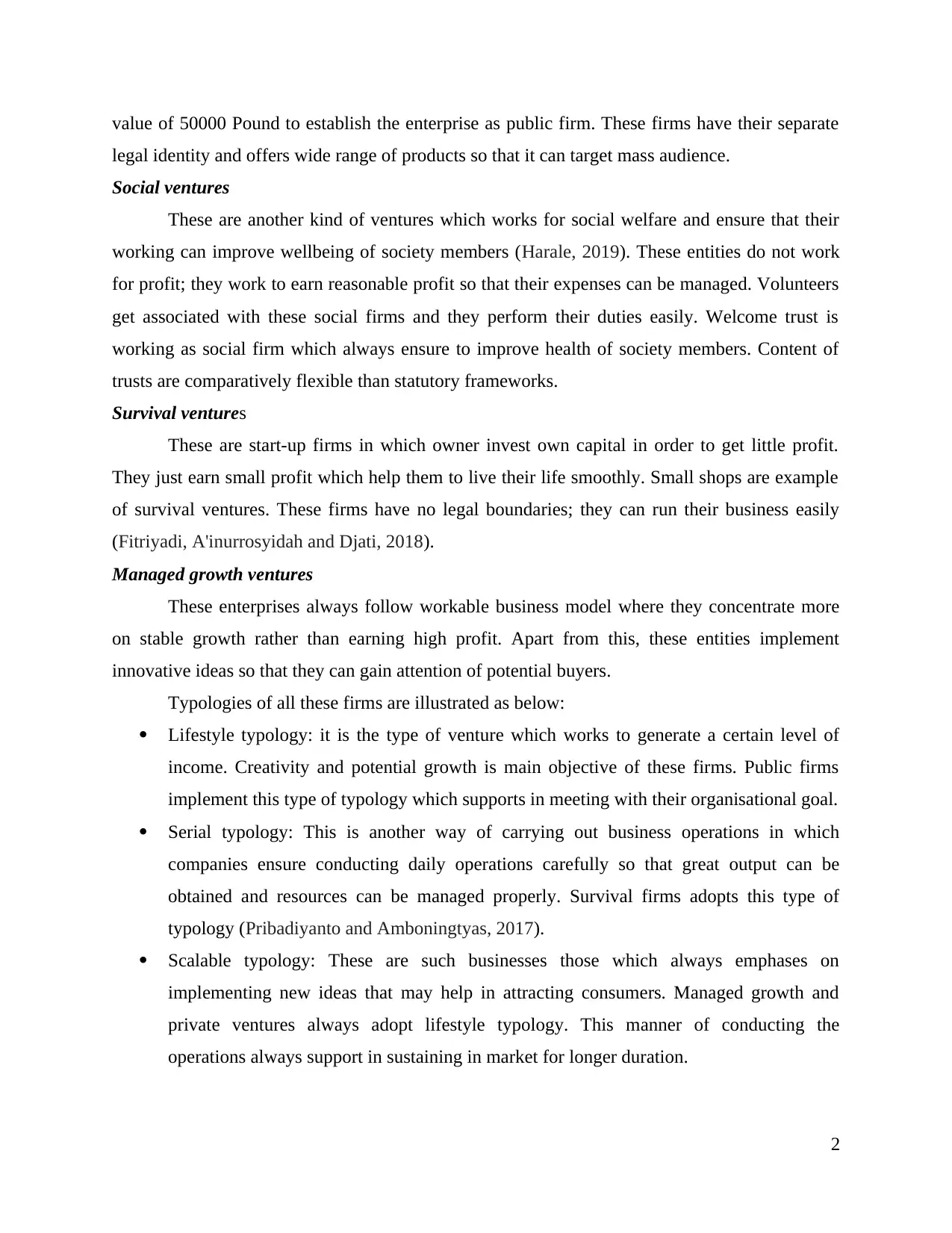
value of 50000 Pound to establish the enterprise as public firm. These firms have their separate
legal identity and offers wide range of products so that it can target mass audience.
Social ventures
These are another kind of ventures which works for social welfare and ensure that their
working can improve wellbeing of society members (Harale, 2019). These entities do not work
for profit; they work to earn reasonable profit so that their expenses can be managed. Volunteers
get associated with these social firms and they perform their duties easily. Welcome trust is
working as social firm which always ensure to improve health of society members. Content of
trusts are comparatively flexible than statutory frameworks.
Survival ventures
These are start-up firms in which owner invest own capital in order to get little profit.
They just earn small profit which help them to live their life smoothly. Small shops are example
of survival ventures. These firms have no legal boundaries; they can run their business easily
(Fitriyadi, A'inurrosyidah and Djati, 2018).
Managed growth ventures
These enterprises always follow workable business model where they concentrate more
on stable growth rather than earning high profit. Apart from this, these entities implement
innovative ideas so that they can gain attention of potential buyers.
Typologies of all these firms are illustrated as below:
Lifestyle typology: it is the type of venture which works to generate a certain level of
income. Creativity and potential growth is main objective of these firms. Public firms
implement this type of typology which supports in meeting with their organisational goal.
Serial typology: This is another way of carrying out business operations in which
companies ensure conducting daily operations carefully so that great output can be
obtained and resources can be managed properly. Survival firms adopts this type of
typology (Pribadiyanto and Amboningtyas, 2017).
Scalable typology: These are such businesses those which always emphases on
implementing new ideas that may help in attracting consumers. Managed growth and
private ventures always adopt lifestyle typology. This manner of conducting the
operations always support in sustaining in market for longer duration.
2
legal identity and offers wide range of products so that it can target mass audience.
Social ventures
These are another kind of ventures which works for social welfare and ensure that their
working can improve wellbeing of society members (Harale, 2019). These entities do not work
for profit; they work to earn reasonable profit so that their expenses can be managed. Volunteers
get associated with these social firms and they perform their duties easily. Welcome trust is
working as social firm which always ensure to improve health of society members. Content of
trusts are comparatively flexible than statutory frameworks.
Survival ventures
These are start-up firms in which owner invest own capital in order to get little profit.
They just earn small profit which help them to live their life smoothly. Small shops are example
of survival ventures. These firms have no legal boundaries; they can run their business easily
(Fitriyadi, A'inurrosyidah and Djati, 2018).
Managed growth ventures
These enterprises always follow workable business model where they concentrate more
on stable growth rather than earning high profit. Apart from this, these entities implement
innovative ideas so that they can gain attention of potential buyers.
Typologies of all these firms are illustrated as below:
Lifestyle typology: it is the type of venture which works to generate a certain level of
income. Creativity and potential growth is main objective of these firms. Public firms
implement this type of typology which supports in meeting with their organisational goal.
Serial typology: This is another way of carrying out business operations in which
companies ensure conducting daily operations carefully so that great output can be
obtained and resources can be managed properly. Survival firms adopts this type of
typology (Pribadiyanto and Amboningtyas, 2017).
Scalable typology: These are such businesses those which always emphases on
implementing new ideas that may help in attracting consumers. Managed growth and
private ventures always adopt lifestyle typology. This manner of conducting the
operations always support in sustaining in market for longer duration.
2
Paraphrase This Document
Need a fresh take? Get an instant paraphrase of this document with our AI Paraphraser
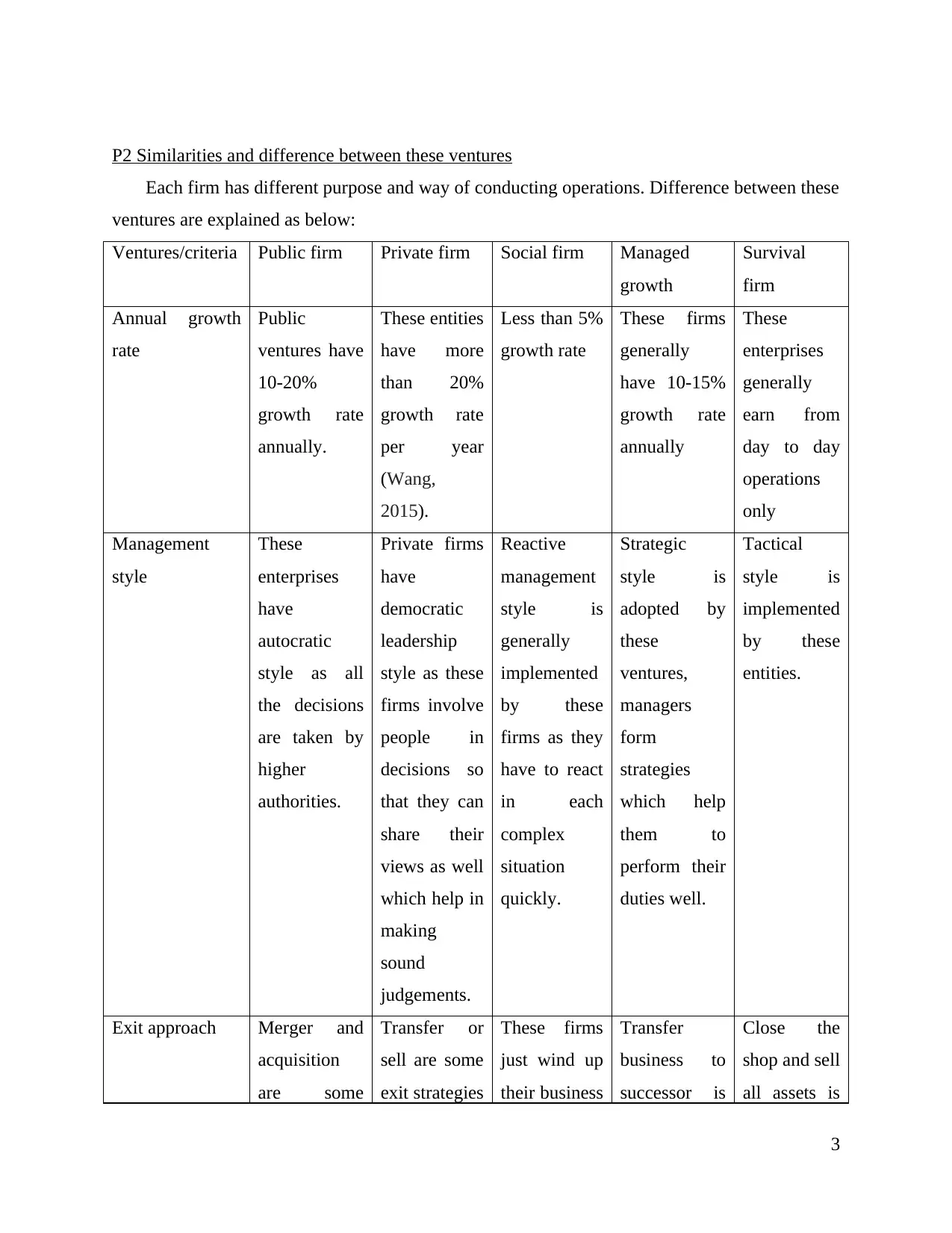
P2 Similarities and difference between these ventures
Each firm has different purpose and way of conducting operations. Difference between these
ventures are explained as below:
Ventures/criteria Public firm Private firm Social firm Managed
growth
Survival
firm
Annual growth
rate
Public
ventures have
10-20%
growth rate
annually.
These entities
have more
than 20%
growth rate
per year
(Wang,
2015).
Less than 5%
growth rate
These firms
generally
have 10-15%
growth rate
annually
These
enterprises
generally
earn from
day to day
operations
only
Management
style
These
enterprises
have
autocratic
style as all
the decisions
are taken by
higher
authorities.
Private firms
have
democratic
leadership
style as these
firms involve
people in
decisions so
that they can
share their
views as well
which help in
making
sound
judgements.
Reactive
management
style is
generally
implemented
by these
firms as they
have to react
in each
complex
situation
quickly.
Strategic
style is
adopted by
these
ventures,
managers
form
strategies
which help
them to
perform their
duties well.
Tactical
style is
implemented
by these
entities.
Exit approach Merger and
acquisition
are some
Transfer or
sell are some
exit strategies
These firms
just wind up
their business
Transfer
business to
successor is
Close the
shop and sell
all assets is
3
Each firm has different purpose and way of conducting operations. Difference between these
ventures are explained as below:
Ventures/criteria Public firm Private firm Social firm Managed
growth
Survival
firm
Annual growth
rate
Public
ventures have
10-20%
growth rate
annually.
These entities
have more
than 20%
growth rate
per year
(Wang,
2015).
Less than 5%
growth rate
These firms
generally
have 10-15%
growth rate
annually
These
enterprises
generally
earn from
day to day
operations
only
Management
style
These
enterprises
have
autocratic
style as all
the decisions
are taken by
higher
authorities.
Private firms
have
democratic
leadership
style as these
firms involve
people in
decisions so
that they can
share their
views as well
which help in
making
sound
judgements.
Reactive
management
style is
generally
implemented
by these
firms as they
have to react
in each
complex
situation
quickly.
Strategic
style is
adopted by
these
ventures,
managers
form
strategies
which help
them to
perform their
duties well.
Tactical
style is
implemented
by these
entities.
Exit approach Merger and
acquisition
are some
Transfer or
sell are some
exit strategies
These firms
just wind up
their business
Transfer
business to
successor is
Close the
shop and sell
all assets is
3

strategies
which are
adopted by
public firms
if these fail to
run business
successfully.
which help
firms in
recovering all
invested
amount and
clear all
debts.
or sell their
assets.
the approach
adopted by
managed
growth
ventures
(Djaddang
and Lysandra,
2018).
only options
of exist from
market.
Structure Public
enterprises
adopt tall
organisational
structure
These
ventures
adopt
divisional
structure
where people
perform their
duties as per
their
capabilities.
Structure of
social firm is
simple and
easy to
understand as
there is no
hierarchy
between
different
people.
Functional
structure is
adopted by
these
ventures.
Flat
structure is
adopted by
this firm.
Rewards Incentives
provided by
firms weekly
Salary is
given by
private firms
alone with
some bonus
No monetary
rewards are
given, people
get appraisals
and
recognition
for their hard
work.
Salaries and
incentives are
given to
employees in
the form of
rewards.
Salaries.
Similarities between these ventures
Though these ventures have some differences but also has some similarities as well. All
these ventures try to implement innovative ideas so that they can improve their performance and
can get more benefits. Funding is common need of all these public, private, social, survival firms
(Motwani, 2016). No matter whether entity is big or small all ventures need funds to run business
4
which are
adopted by
public firms
if these fail to
run business
successfully.
which help
firms in
recovering all
invested
amount and
clear all
debts.
or sell their
assets.
the approach
adopted by
managed
growth
ventures
(Djaddang
and Lysandra,
2018).
only options
of exist from
market.
Structure Public
enterprises
adopt tall
organisational
structure
These
ventures
adopt
divisional
structure
where people
perform their
duties as per
their
capabilities.
Structure of
social firm is
simple and
easy to
understand as
there is no
hierarchy
between
different
people.
Functional
structure is
adopted by
these
ventures.
Flat
structure is
adopted by
this firm.
Rewards Incentives
provided by
firms weekly
Salary is
given by
private firms
alone with
some bonus
No monetary
rewards are
given, people
get appraisals
and
recognition
for their hard
work.
Salaries and
incentives are
given to
employees in
the form of
rewards.
Salaries.
Similarities between these ventures
Though these ventures have some differences but also has some similarities as well. All
these ventures try to implement innovative ideas so that they can improve their performance and
can get more benefits. Funding is common need of all these public, private, social, survival firms
(Motwani, 2016). No matter whether entity is big or small all ventures need funds to run business
4
⊘ This is a preview!⊘
Do you want full access?
Subscribe today to unlock all pages.

Trusted by 1+ million students worldwide
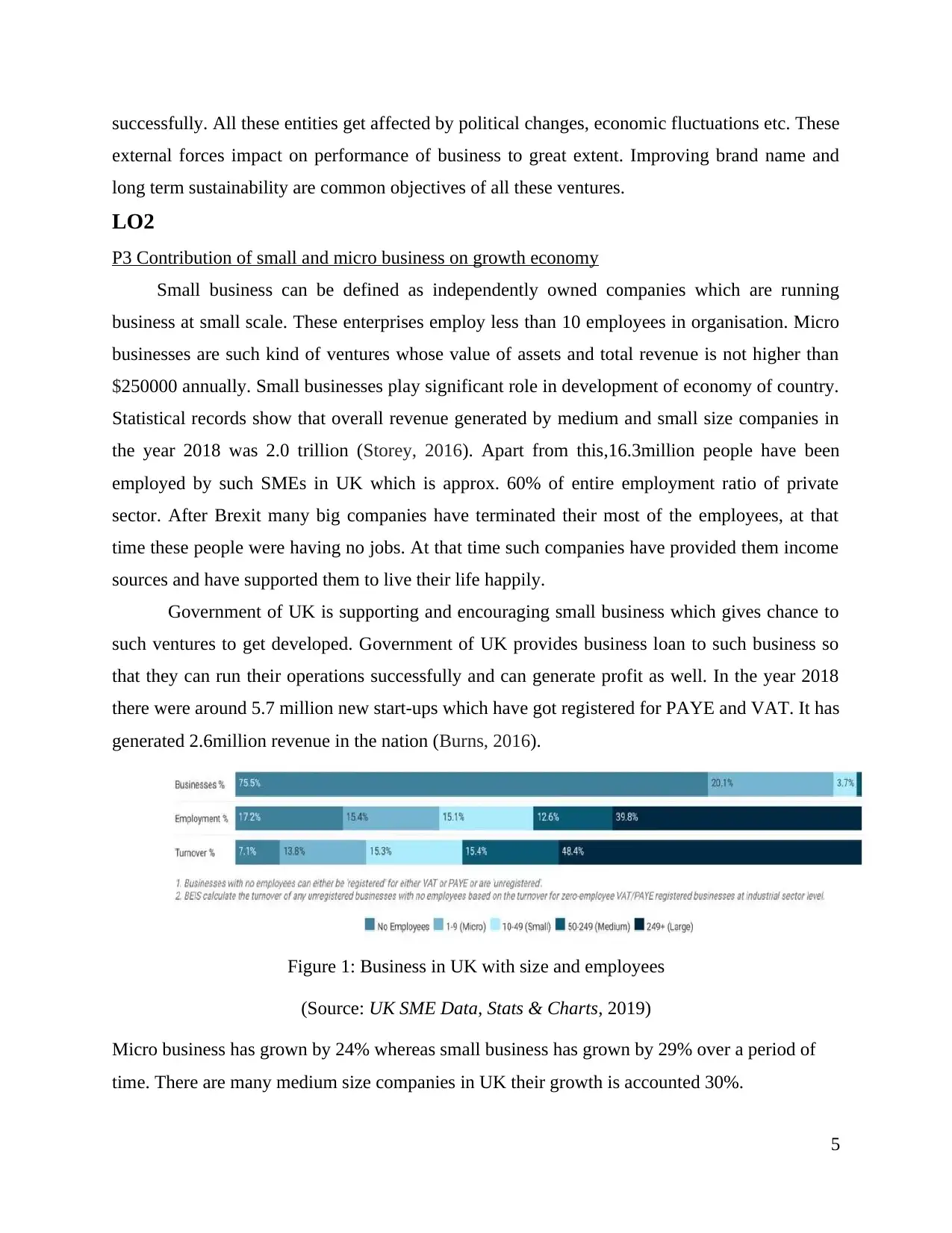
successfully. All these entities get affected by political changes, economic fluctuations etc. These
external forces impact on performance of business to great extent. Improving brand name and
long term sustainability are common objectives of all these ventures.
LO2
P3 Contribution of small and micro business on growth economy
Small business can be defined as independently owned companies which are running
business at small scale. These enterprises employ less than 10 employees in organisation. Micro
businesses are such kind of ventures whose value of assets and total revenue is not higher than
$250000 annually. Small businesses play significant role in development of economy of country.
Statistical records show that overall revenue generated by medium and small size companies in
the year 2018 was 2.0 trillion (Storey, 2016). Apart from this,16.3million people have been
employed by such SMEs in UK which is approx. 60% of entire employment ratio of private
sector. After Brexit many big companies have terminated their most of the employees, at that
time these people were having no jobs. At that time such companies have provided them income
sources and have supported them to live their life happily.
Government of UK is supporting and encouraging small business which gives chance to
such ventures to get developed. Government of UK provides business loan to such business so
that they can run their operations successfully and can generate profit as well. In the year 2018
there were around 5.7 million new start-ups which have got registered for PAYE and VAT. It has
generated 2.6million revenue in the nation (Burns, 2016).
Figure 1: Business in UK with size and employees
(Source: UK SME Data, Stats & Charts, 2019)
Micro business has grown by 24% whereas small business has grown by 29% over a period of
time. There are many medium size companies in UK their growth is accounted 30%.
5
external forces impact on performance of business to great extent. Improving brand name and
long term sustainability are common objectives of all these ventures.
LO2
P3 Contribution of small and micro business on growth economy
Small business can be defined as independently owned companies which are running
business at small scale. These enterprises employ less than 10 employees in organisation. Micro
businesses are such kind of ventures whose value of assets and total revenue is not higher than
$250000 annually. Small businesses play significant role in development of economy of country.
Statistical records show that overall revenue generated by medium and small size companies in
the year 2018 was 2.0 trillion (Storey, 2016). Apart from this,16.3million people have been
employed by such SMEs in UK which is approx. 60% of entire employment ratio of private
sector. After Brexit many big companies have terminated their most of the employees, at that
time these people were having no jobs. At that time such companies have provided them income
sources and have supported them to live their life happily.
Government of UK is supporting and encouraging small business which gives chance to
such ventures to get developed. Government of UK provides business loan to such business so
that they can run their operations successfully and can generate profit as well. In the year 2018
there were around 5.7 million new start-ups which have got registered for PAYE and VAT. It has
generated 2.6million revenue in the nation (Burns, 2016).
Figure 1: Business in UK with size and employees
(Source: UK SME Data, Stats & Charts, 2019)
Micro business has grown by 24% whereas small business has grown by 29% over a period of
time. There are many medium size companies in UK their growth is accounted 30%.
5
Paraphrase This Document
Need a fresh take? Get an instant paraphrase of this document with our AI Paraphraser
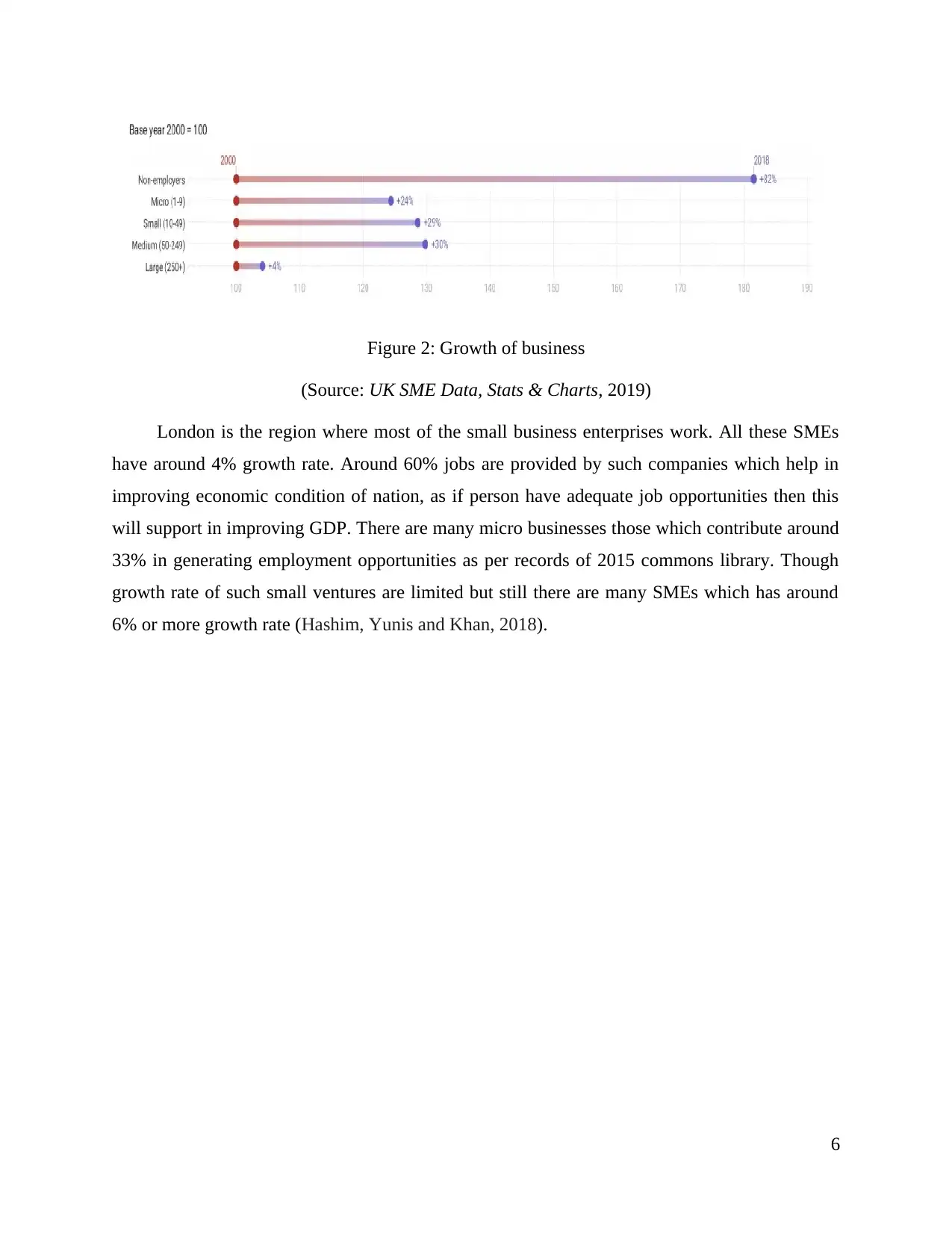
Figure 2: Growth of business
(Source: UK SME Data, Stats & Charts, 2019)
London is the region where most of the small business enterprises work. All these SMEs
have around 4% growth rate. Around 60% jobs are provided by such companies which help in
improving economic condition of nation, as if person have adequate job opportunities then this
will support in improving GDP. There are many micro businesses those which contribute around
33% in generating employment opportunities as per records of 2015 commons library. Though
growth rate of such small ventures are limited but still there are many SMEs which has around
6% or more growth rate (Hashim, Yunis and Khan, 2018).
6
(Source: UK SME Data, Stats & Charts, 2019)
London is the region where most of the small business enterprises work. All these SMEs
have around 4% growth rate. Around 60% jobs are provided by such companies which help in
improving economic condition of nation, as if person have adequate job opportunities then this
will support in improving GDP. There are many micro businesses those which contribute around
33% in generating employment opportunities as per records of 2015 commons library. Though
growth rate of such small ventures are limited but still there are many SMEs which has around
6% or more growth rate (Hashim, Yunis and Khan, 2018).
6

Figure 3: Average profit o SMEs
(Source: UK SME Data, Stats & Charts, 2019)
Statistics show that there are many SMEs which has less than 25m turnover rate and most
of these firms are operating in hospitality and retail industry.
7
(Source: UK SME Data, Stats & Charts, 2019)
Statistics show that there are many SMEs which has less than 25m turnover rate and most
of these firms are operating in hospitality and retail industry.
7
⊘ This is a preview!⊘
Do you want full access?
Subscribe today to unlock all pages.

Trusted by 1+ million students worldwide
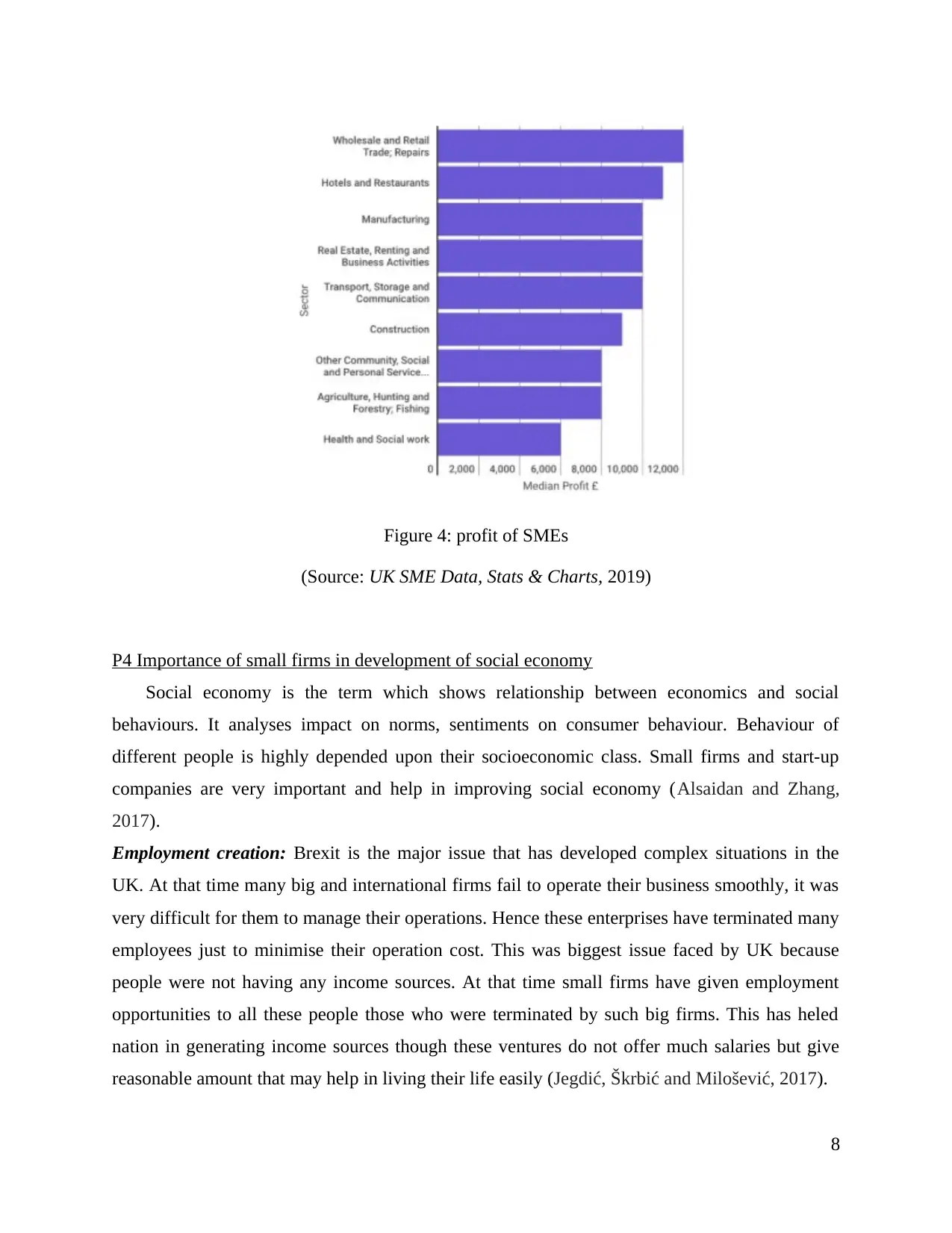
Figure 4: profit of SMEs
(Source: UK SME Data, Stats & Charts, 2019)
P4 Importance of small firms in development of social economy
Social economy is the term which shows relationship between economics and social
behaviours. It analyses impact on norms, sentiments on consumer behaviour. Behaviour of
different people is highly depended upon their socioeconomic class. Small firms and start-up
companies are very important and help in improving social economy (Alsaidan and Zhang,
2017).
Employment creation: Brexit is the major issue that has developed complex situations in the
UK. At that time many big and international firms fail to operate their business smoothly, it was
very difficult for them to manage their operations. Hence these enterprises have terminated many
employees just to minimise their operation cost. This was biggest issue faced by UK because
people were not having any income sources. At that time small firms have given employment
opportunities to all these people those who were terminated by such big firms. This has heled
nation in generating income sources though these ventures do not offer much salaries but give
reasonable amount that may help in living their life easily (Jegdić, Škrbić and Milošević, 2017).
8
(Source: UK SME Data, Stats & Charts, 2019)
P4 Importance of small firms in development of social economy
Social economy is the term which shows relationship between economics and social
behaviours. It analyses impact on norms, sentiments on consumer behaviour. Behaviour of
different people is highly depended upon their socioeconomic class. Small firms and start-up
companies are very important and help in improving social economy (Alsaidan and Zhang,
2017).
Employment creation: Brexit is the major issue that has developed complex situations in the
UK. At that time many big and international firms fail to operate their business smoothly, it was
very difficult for them to manage their operations. Hence these enterprises have terminated many
employees just to minimise their operation cost. This was biggest issue faced by UK because
people were not having any income sources. At that time small firms have given employment
opportunities to all these people those who were terminated by such big firms. This has heled
nation in generating income sources though these ventures do not offer much salaries but give
reasonable amount that may help in living their life easily (Jegdić, Škrbić and Milošević, 2017).
8
Paraphrase This Document
Need a fresh take? Get an instant paraphrase of this document with our AI Paraphraser
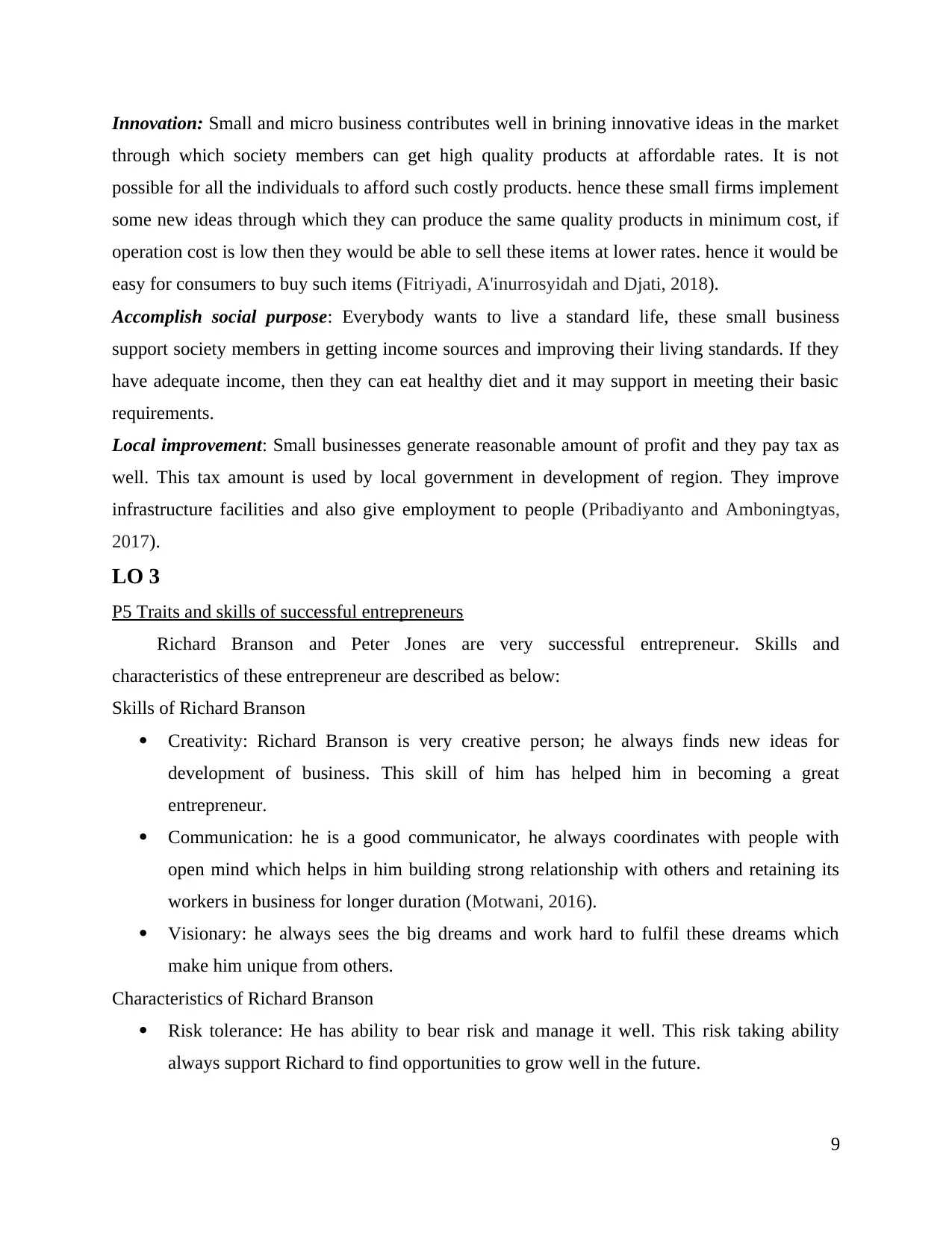
Innovation: Small and micro business contributes well in brining innovative ideas in the market
through which society members can get high quality products at affordable rates. It is not
possible for all the individuals to afford such costly products. hence these small firms implement
some new ideas through which they can produce the same quality products in minimum cost, if
operation cost is low then they would be able to sell these items at lower rates. hence it would be
easy for consumers to buy such items (Fitriyadi, A'inurrosyidah and Djati, 2018).
Accomplish social purpose: Everybody wants to live a standard life, these small business
support society members in getting income sources and improving their living standards. If they
have adequate income, then they can eat healthy diet and it may support in meeting their basic
requirements.
Local improvement: Small businesses generate reasonable amount of profit and they pay tax as
well. This tax amount is used by local government in development of region. They improve
infrastructure facilities and also give employment to people (Pribadiyanto and Amboningtyas,
2017).
LO 3
P5 Traits and skills of successful entrepreneurs
Richard Branson and Peter Jones are very successful entrepreneur. Skills and
characteristics of these entrepreneur are described as below:
Skills of Richard Branson
Creativity: Richard Branson is very creative person; he always finds new ideas for
development of business. This skill of him has helped him in becoming a great
entrepreneur.
Communication: he is a good communicator, he always coordinates with people with
open mind which helps in him building strong relationship with others and retaining its
workers in business for longer duration (Motwani, 2016).
Visionary: he always sees the big dreams and work hard to fulfil these dreams which
make him unique from others.
Characteristics of Richard Branson
Risk tolerance: He has ability to bear risk and manage it well. This risk taking ability
always support Richard to find opportunities to grow well in the future.
9
through which society members can get high quality products at affordable rates. It is not
possible for all the individuals to afford such costly products. hence these small firms implement
some new ideas through which they can produce the same quality products in minimum cost, if
operation cost is low then they would be able to sell these items at lower rates. hence it would be
easy for consumers to buy such items (Fitriyadi, A'inurrosyidah and Djati, 2018).
Accomplish social purpose: Everybody wants to live a standard life, these small business
support society members in getting income sources and improving their living standards. If they
have adequate income, then they can eat healthy diet and it may support in meeting their basic
requirements.
Local improvement: Small businesses generate reasonable amount of profit and they pay tax as
well. This tax amount is used by local government in development of region. They improve
infrastructure facilities and also give employment to people (Pribadiyanto and Amboningtyas,
2017).
LO 3
P5 Traits and skills of successful entrepreneurs
Richard Branson and Peter Jones are very successful entrepreneur. Skills and
characteristics of these entrepreneur are described as below:
Skills of Richard Branson
Creativity: Richard Branson is very creative person; he always finds new ideas for
development of business. This skill of him has helped him in becoming a great
entrepreneur.
Communication: he is a good communicator, he always coordinates with people with
open mind which helps in him building strong relationship with others and retaining its
workers in business for longer duration (Motwani, 2016).
Visionary: he always sees the big dreams and work hard to fulfil these dreams which
make him unique from others.
Characteristics of Richard Branson
Risk tolerance: He has ability to bear risk and manage it well. This risk taking ability
always support Richard to find opportunities to grow well in the future.
9
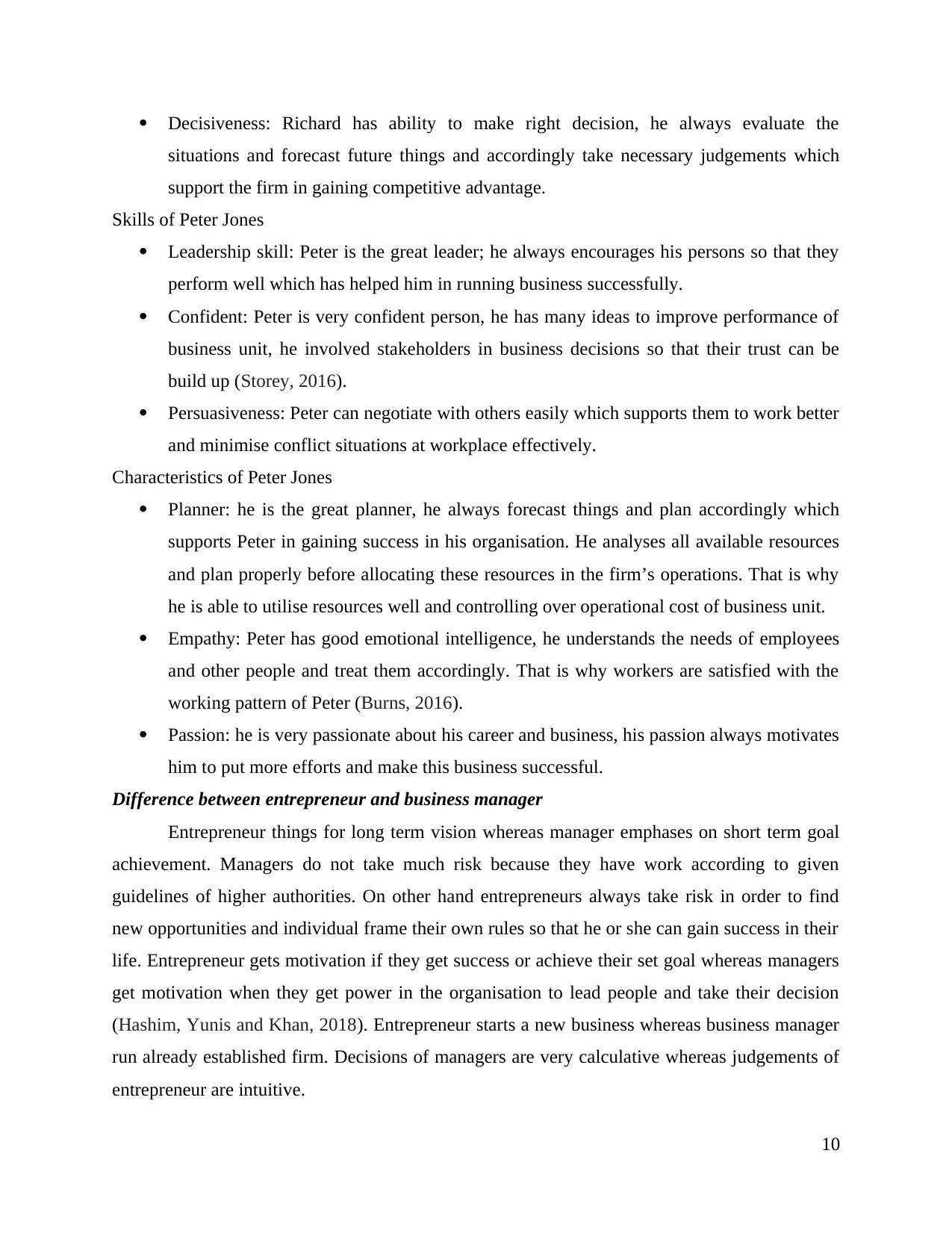
Decisiveness: Richard has ability to make right decision, he always evaluate the
situations and forecast future things and accordingly take necessary judgements which
support the firm in gaining competitive advantage.
Skills of Peter Jones
Leadership skill: Peter is the great leader; he always encourages his persons so that they
perform well which has helped him in running business successfully.
Confident: Peter is very confident person, he has many ideas to improve performance of
business unit, he involved stakeholders in business decisions so that their trust can be
build up (Storey, 2016).
Persuasiveness: Peter can negotiate with others easily which supports them to work better
and minimise conflict situations at workplace effectively.
Characteristics of Peter Jones
Planner: he is the great planner, he always forecast things and plan accordingly which
supports Peter in gaining success in his organisation. He analyses all available resources
and plan properly before allocating these resources in the firm’s operations. That is why
he is able to utilise resources well and controlling over operational cost of business unit.
Empathy: Peter has good emotional intelligence, he understands the needs of employees
and other people and treat them accordingly. That is why workers are satisfied with the
working pattern of Peter (Burns, 2016).
Passion: he is very passionate about his career and business, his passion always motivates
him to put more efforts and make this business successful.
Difference between entrepreneur and business manager
Entrepreneur things for long term vision whereas manager emphases on short term goal
achievement. Managers do not take much risk because they have work according to given
guidelines of higher authorities. On other hand entrepreneurs always take risk in order to find
new opportunities and individual frame their own rules so that he or she can gain success in their
life. Entrepreneur gets motivation if they get success or achieve their set goal whereas managers
get motivation when they get power in the organisation to lead people and take their decision
(Hashim, Yunis and Khan, 2018). Entrepreneur starts a new business whereas business manager
run already established firm. Decisions of managers are very calculative whereas judgements of
entrepreneur are intuitive.
10
situations and forecast future things and accordingly take necessary judgements which
support the firm in gaining competitive advantage.
Skills of Peter Jones
Leadership skill: Peter is the great leader; he always encourages his persons so that they
perform well which has helped him in running business successfully.
Confident: Peter is very confident person, he has many ideas to improve performance of
business unit, he involved stakeholders in business decisions so that their trust can be
build up (Storey, 2016).
Persuasiveness: Peter can negotiate with others easily which supports them to work better
and minimise conflict situations at workplace effectively.
Characteristics of Peter Jones
Planner: he is the great planner, he always forecast things and plan accordingly which
supports Peter in gaining success in his organisation. He analyses all available resources
and plan properly before allocating these resources in the firm’s operations. That is why
he is able to utilise resources well and controlling over operational cost of business unit.
Empathy: Peter has good emotional intelligence, he understands the needs of employees
and other people and treat them accordingly. That is why workers are satisfied with the
working pattern of Peter (Burns, 2016).
Passion: he is very passionate about his career and business, his passion always motivates
him to put more efforts and make this business successful.
Difference between entrepreneur and business manager
Entrepreneur things for long term vision whereas manager emphases on short term goal
achievement. Managers do not take much risk because they have work according to given
guidelines of higher authorities. On other hand entrepreneurs always take risk in order to find
new opportunities and individual frame their own rules so that he or she can gain success in their
life. Entrepreneur gets motivation if they get success or achieve their set goal whereas managers
get motivation when they get power in the organisation to lead people and take their decision
(Hashim, Yunis and Khan, 2018). Entrepreneur starts a new business whereas business manager
run already established firm. Decisions of managers are very calculative whereas judgements of
entrepreneur are intuitive.
10
⊘ This is a preview!⊘
Do you want full access?
Subscribe today to unlock all pages.

Trusted by 1+ million students worldwide
1 out of 16
Related Documents
Your All-in-One AI-Powered Toolkit for Academic Success.
+13062052269
info@desklib.com
Available 24*7 on WhatsApp / Email
![[object Object]](/_next/static/media/star-bottom.7253800d.svg)
Unlock your academic potential
Copyright © 2020–2025 A2Z Services. All Rights Reserved. Developed and managed by ZUCOL.





